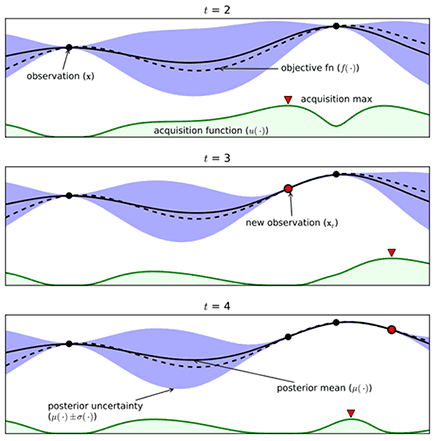
V1Bayes
polyaxon._flow.matrix.bayes.V1Bayes()Bayesian optimization is an extremely powerful technique. The main idea behind it is to compute a posterior distribution over the objective function based on the data, and then select good points to try with respect to this distribution.
The way Polyaxon performs bayesian optimization is by measuring the expected increase in the maximum objective value seen over all experiments in the group, given the next point we pick.
- Args:
- kind: string, should be equal to
bayes - utility_function: UtilityFunctionConfig
- num_initial_runs: int
- max_iterations: int
- metric: V1OptimizationMetric
- params: List[Dict[str, params]]
- seed: int, optional
- concurrency: int, optional
- tuner: V1Tuner, optional
- early_stopping: List[EarlyStopping], optional
- kind: string, should be equal to
YAML usage
matrix:
kind: bayes
utilityFunction:
numInitialRuns:
maxIterations:
metric:
params:
seed:
concurrency:
tuner:
earlyStopping:Python usage
from polyaxon import types
from polyaxon.schemas import (
V1Bayes, V1HpLogSpace, V1HpChoice, V1FailureEarlyStopping, V1MetricEarlyStopping,
V1OptimizationMetric, V1Optimization, V1OptimizationResource, UtilityFunctionConfig
)
matrix = V1Bayes(
concurrency=20,
utility_function=UtilityFunctionConfig(...),
num_initial_runs=40,
max_iterations=20,
params={"param1": V1HpLogSpace(...), "param2": V1HpChoice(...), ... },
metric=V1OptimizationMetric(name="loss", optimization=V1Optimization.MINIMIZE),
early_stopping=[V1FailureEarlyStopping(...), V1MetricEarlyStopping(...)]
)Fields
kind
The kind signals to the CLI, client, and other tools that this matrix is bayes.
If you are using the python client to create the mapping, this field is not required and is set by default.
matrix:
kind: bayesparams
A dictionary of key -> value generator
to generate the parameters.
To learn about all possible params generators.
The parameters generated will be validated against the component’s inputs/outputs definition to check that the values can be passed and have valid types.
matrix:
kind: bayes
params:
param1:
kind: ...
value: ...
param2:
kind: ...
value: ...utilityFunction
the utility function defines what acquisition function and bayesian process to use.
Acquisition functions
A couple of acquisition functions can be used: ucb, ei or poi.
ucb: Upper Confidence Bound,ei: Expected Improvementpoi: Probability of Improvement
When using ucb as acquisition function, a tunable parameter kappa
is also required, to balance exploitation against exploration, increasing kappa
will make the optimized hyperparameters pursuing exploration.
When using ei or poi as acquisition function, a tunable parameter eps is also required,
to balance exploitation against exploration, increasing epsilon will
make the optimized hyperparameters more spread out across the whole range.
Gaussian process
Polyaxon allows to tune the gaussian process.
kernel:maternorrbf.lengthScale: floatnu: floatnumRestartsOptimizer: int
matrix:
kind: bayes
utility_function:
acquisitionFunction: ucb
kappa: 1.2
gaussianProcess:
kernel: matern
lengthScale: 1.0
nu: 1.9
numRestartsOptimizer: 0numInitialRuns
the initial iteration of random experiments is required to create a seed of observations.
This initial random results are used by the algorithm to update the regression model for generating the next suggestions.
matrix:
kind: bayes
numInitialRuns: 40maxIterations
After creating the first set of random observations, the algorithm will use these results to update the regression model and suggest a new experiment to run.
Every time an experiment is done, the results are used as an observation and are appended to the historical values so that the algorithm can use all the observations again to suggest more experiments to run.
The algorithm will keep suggesting more experiments and adding their results as an observation, every time we make a new observation, i.e. an experiment finishes and reports the results to the platform, the results are appended to the historical values, and then used to make a better suggestion.
matrix:
kind: bayes
maxIterations: 15This configuration will make 15 suggestions based on the historical values, every time an observation is made is appended to the historical values to make better subsequent suggestions.
metric
The metric to optimize during the iterations, this is the metric that you want to maximize or minimize.
matrix:
kind: bayes
metric:
name: loss
optimization: minimizeseed
Since this algorithm uses random generators, if you want to control the seed for the random generator, you can pass a seed.
matrix:
kind: bayes
seed: 523concurrency
An optional value to set the number of concurrent operations.
This value only makes sense if less or equal to the total number of possible runs.
matrix:
kind: bayes
concurrency: 20For more details about concurrency management, please check the concurrency section.
earlyStopping
A list of early stopping conditions to check for terminating all operations managed by the pipeline. If one of the early stopping conditions is met, a signal will be sent to terminate all running and pending operations.
matrix:
kind: bayes
earlyStopping: ...For more details please check the early stopping section.
tuner
The tuner reference (w/o component hub reference) to use. The component contains the logic for creating new suggestions based on bayesian optimization, users can override this section to provide a different tuner component.
matrix:
kind: bayes
tuner:
hubRef: 'acme/my-bo-tuner:version'Example
This is an example of using bayesian search for hyperparameter tuning:
matrix:
kind: bayes
concurrency: 5
maxIterations: 15
numInitialTrials: 30
metric:
name: loss
optimization: minimize
utilityFunction:
acquisitionFunction: ucb
kappa: 1.2
gaussianProcess:
kernel: matern
lengthScale: 1.0
nu: 1.9
numRestartsOptimizer: 0
params:
lr:
kind: uniform
value: [0, 0.9]
dropout:
kind: choice
value: [0.25, 0.3]
activation:
kind: pchoice
value: [[relu, 0.1], [sigmoid, 0.8]]
component:
inputs:
- name: batch_size
type: int
isOptional: true
value: 128
- name: lr
type: float
- name: dropout
type: float
container:
image: image:latest
command: [python3, train.py]
args: [
"--batch-size={{ batch_size }}",
"--lr={{ lr }}",
"--dropout={{ dropout }}",
"--activation={{ activation }}"